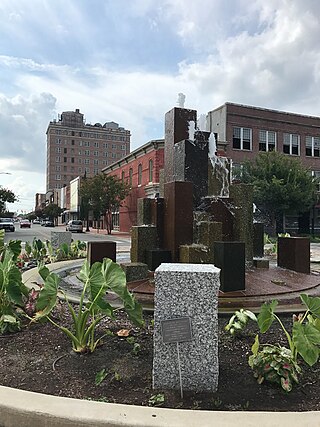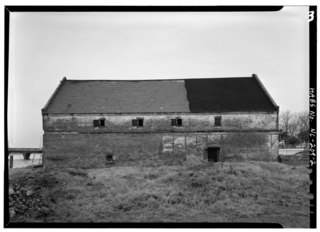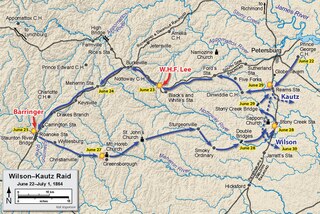
Kinston is a city in Lenoir County, North Carolina, United States, with a population of 19,900 as of the 2020 census. It has been the county seat of Lenoir County since its formation in 1791. Kinston is located in the coastal plains region of eastern North Carolina.

Goldsboro, originally Goldsborough, is a city in and the county seat of Wayne County, North Carolina, United States. The population was 33,657 at the 2020 census. It is the principal city of and is included in the Goldsboro, North Carolina Metropolitan Statistical Area. The nearby town of Waynesboro was founded in 1787, and Goldsboro was incorporated in 1847. It is the county seat of Wayne County.

The Battle of New Bern was fought on March 14, 1862, near the city of New Bern, North Carolina, as part of the Burnside Expedition of the American Civil War. The US Army's Coast Division, led by Brigadier General Ambrose Burnside and accompanied by armed vessels from the North Atlantic Blockading Squadron, were opposed by an undermanned and badly trained Confederate force of North Carolina soldiers and militia led by Brigadier General Lawrence O'B. Branch. Although the defenders fought behind breastworks that had been set up before the battle, their line had a weak spot in its center that was exploited by the attacking Federal soldiers. When the center of the line was penetrated, many of the militia broke, forcing a general retreat of the entire Confederate force. General Branch was unable to regain control of his troops until they had retreated to Kinston, more than 30 miles away. New Bern came under Federal control, and remained so for the rest of the war.
The First Battle of Chattanooga was a minor artillery battle in the American Civil War, fought on June 7–8, 1862.
The Battle of White Hall, also called the Battle of White Hall Ferry, took place on December 16, 1862, in Wayne County, North Carolina, as part of the Union expedition to Goldsborough, North Carolina, during the American Civil War.

The Battle of Goldsborough Bridge took place on December 17, 1862, in Wayne County, North Carolina, as part of the Union expedition to Goldsborough, North Carolina, during the American Civil War.

The Battle of Washington took place from March 30 to April 19, 1863, in Beaufort County, North Carolina. It was part of the Confederate Tidewater operations conducted by Lieutenant General James Longstreet during the American Civil War. This battle is sometimes referred to as the siege of Little Washington.

The Battle of Aldie took place on June 17, 1863, in Loudoun County, Virginia, as part of the Gettysburg Campaign of the American Civil War.

The Battle of Jackson, also known as the Battle of Salem Cemetery, was fought on December 19, 1862, in Madison County, Tennessee, during the American Civil War.

The Battle of Parker's Cross Roads was fought on December 31, 1862, in Henderson County, Tennessee, during the American Civil War.

The Battle of Middle Creek was an engagement fought January 10, 1862, in Eastern Kentucky during the American Civil War. It was the only battle personally commanded by future president James A. Garfield, then a colonel in the Union Army.
The Battle of Wyse Fork, also known as the Battle of Kinston, was fought in the Carolinas Campaign of the American Civil War, resulting in a Union Army victory.
The Battle of Buckland Mills, also known as The Buckland Races or Chestnut Hill, was fought on October 19, 1863, between Union and Confederate forces in the American Civil War. Union cavalry led by Brig. Gen. Judson Kilpatrick were caught in a Confederate ambush and defeated.

The First Battle of Ream's Station was fought on June 29, 1864, during the Wilson–Kautz Raid of the American Civil War. Confederate forces under Maj. Gen. William Mahone and Brig. Gen. Fitzhugh Lee defeated Union cavalry raiding Confederate railroads south of Petersburg, Virginia.
The 9th New Jersey Infantry Regiment was an American Civil War infantry regiment from New Jersey that served from October 1861 through July 1865 in the Union Army. The regiment got its nickname, Jersey Muskrats, during the Battle of Roanoke Island when they successfully "sloshed through shoe sucking mud into waist deep water in "division" formation", giving the regiment a two-company front flanking the enemy. The regiment was the last to leave the state in 1861 but the first to see battle.

The First Battle of Deep Bottom, also known as Darbytown, Strawberry Plains, New Market Road, or Gravel Hill, was fought July 27–29, 1864, at Deep Bottom in Henrico County, Virginia, as part of the Siege of Petersburg of the American Civil War. A Union force under Maj. Gens. Winfield S. Hancock and Philip H. Sheridan was sent on an expedition threatening Richmond, Virginia, and its railroads, intending to attract Confederate troops away from the Petersburg defensive line, in anticipation of the upcoming Battle of the Crater. The Union infantry and cavalry force was unable to break through the Confederate fortifications at Bailey's Creek and Fussell's Mill and was withdrawn, but it achieved its desired effect of momentarily reducing Confederate strength at Petersburg.
Burnside's North Carolina Expedition was a series of engagements fought along the North Carolina Coast between February and June 1862. The expedition was part of Winfield Scott's overall Anaconda Plan, which aimed at closing blockade-running ports inside the Outer Banks. The amphibious operation was carried out primarily by New England and North Carolina troops under Brig. Gen. Ambrose E. Burnside and assisted by the North Atlantic Blockading Squadron under Captain Louis M. Goldsborough.

The Battle of New Bern was fought during the American Civil War from February 1–3, 1864. The battle resulted in the failure of Confederate forces trying to recapture the coastal town of New Bern which had been lost to the Union Army in 1862.
23rd Regiment Massachusetts Volunteer Infantry was an infantry regiment in the Union army during the American Civil War. It was formed on 28 September 1861 in Lynnfield, Massachusetts, though some of the men were not mustered until the regiment's arrival to Annapolis, Maryland on 5 December, and comprised 6 companies from Essex County, Massachusetts and 1 each from Bristol, Plymouth, Middlesex and Worcester. An ex-militia officer, John Kurtz, was commissioned its colonel.

The 3rd Massachusetts Volunteer Militia Regiment was a peacetime regiment of infantry that was activated for federal service in the Union Army for two separate tours during the American Civil War. The regiment consisted of companies from Plymouth and Bristol Counties.




















